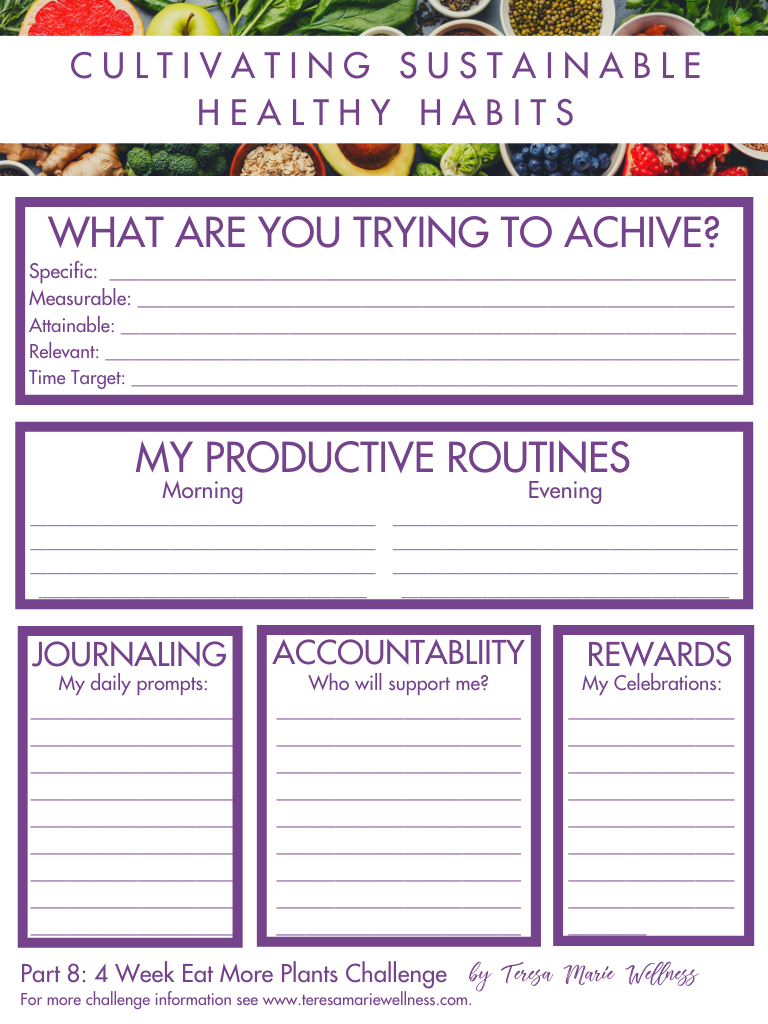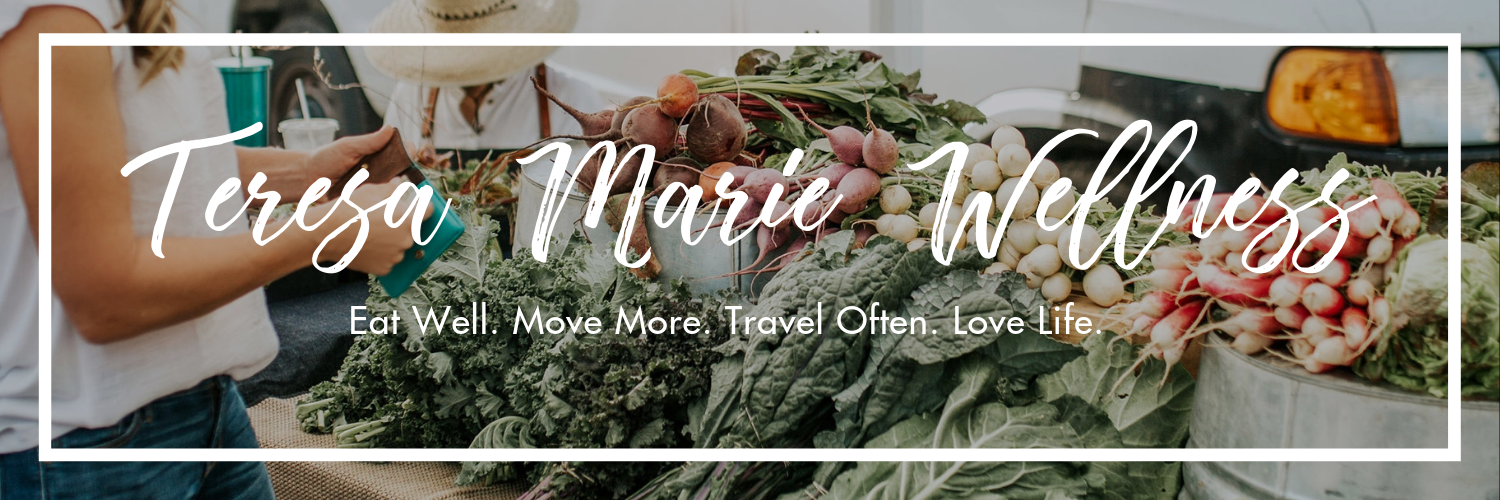Part 8: Cultivating Sustainable Healthy Habits

Making permanent lifestyle changes, the ones that support better health, can be hard. If it wasn’t, we’d all be perfect already, right? But it can also be done. I’ve seen it happen. Not just in my own life and those close to me, but in clients near and far. With dedication and attention, you can be successful at cultivating sustainable healthy habits! And that is what we’re talking about today.
This is the final lesson in the 4-Week Eat More Plants Challenge. As a reminder, here is where we’ve been so far:
- Welcome: What is a Plant Forward Diet
- Setting up Your Plant Forward Pantry
- When Organic Food is Worth the Cost
- Calculate How Much Protein YOUR Body Needs
- The Best Sources of Traditional & Plant Based Proteins
- Preventing Food Waste with Proper Food Storage
- Which Plants Can Cause Bloating and Inflammation
- Cultivating Sustainable Healthy Habits <== You are Here
Cultivating Sustainable Healthy Habits
Habits are so interesting. If you have time, I strongly recommend reading the Power of Habit by Charles Duhigg. It’s a fascinating read and can be a game changer when looking to understand the basis of habits and how to successfully make change.
Essentially, the habit loop: Cue, Routine, Reward is what drives most of our automatic behavior. In other words:
- There is a trigger.
- You do something.
- You get something out of it.
When you’re looking to make change, you need to understand what you’re seeking with that reward (it’s not always so obvious). Then change either the cue or the routine to achieve that same reward.
Here are some of what I have found to be the most effective habits, cues or routines to put into place so that you find rewards with a positive outcome.
SMART Goals
It all starts with goal setting, which is often classified as a productive habit. While not a cue or a routine, to find or measure success, you first need to define what it would look like. And you can’t just say “I want to be healthier.” I mean, how would you know if you were? You need to define that with a SMART goal and it may look something like this:
- Specific: I will improve my diet quality by eating more plants.
- Measurable: I will eat at least 5 servings of vegetables, all 5 colors per day.
- Attainable: I can easily do this by completing the action steps in the 4-Week Eat More Plants Challenge.
- Relevant: This matters to me because my blood pressure is up and I don’t want to start taking medication.
- Time Target: I will complete this by the end of the month.
So, goals are super subjective and definitely have to matter to you. I used that fairly corny example above, but hopefully it gives you the idea of how to chisel out a goal so that you want it, can see it, have a path to success and a way to measure that. So whether you want to lose weight, improve sleep, move a bio marker like blood pressure or cholesterol or help a loved one. All of those goals can be defined so that you increase your chances of success.
Morning Routine
Once you have your goals set, let’s talk about the most basic of cues: waking up. We all do it. Every dang day. What’s the first thing you do (routine)? Why (reward)? Is that a positive habit loop? Are there any other, more productive habits you may want to incorporate into your morning routine? Here are some of the most productive, keystone habits you can consider putting into your morning routine:
- Drinking 16+oz Water
- Exercise
- Stretch
- Meditate
- Journal
- Make your bed
- Have a power smoothie
- Set goals for the day
Evening Routine
Just as you start your day intentional, you can also end your day with a productive evening routine. The cue here will be different for all of us. Maybe it starts right after dinner? Maybe it starts an hour before bedtime? Identify your cue, which triggers your routine. See if you like it. If you want to make some enhancements, here are some productive habits to put into an evening routine.
- Turn off technology X amount of time before bed
- Eat a healthy dinner at least 3 hours before bed
- Do the dishes and put them away
- Review daily goals
- Practice gratitude
- Journal
- Set up your morning
- Read
Journaling
I included journaling in both the morning and evening routines as a productive habit. But what does it mean and why does it matter? Well, for a lot of reasons. But let’s start with it helps improve your mood by helping you prioritize. Prioritize what? The stuff that floats around in the back of your mind causing low levels of stress and anxiety. Things like fears, problems, concerns, challenges. Realistic and significant or not, those thoughts can be made much more productive by putting them objectively on paper.
It also helps you track your moods day-to-day so that you can recognize positive and negative triggers and learn ways to better control them. Journalling also gives you the chance to practice positive self-talk and identifying negative thoughts. And in the simplest form, it helps you identify motivations for goals, and allows you to track your progress towards them.
So how do you get started? Simple. Get a journal and a pen then carve out some time in the morning and/or the evening and ask yourself questions like this:
- What brings you joy?
- Thing about something is one thing that you’d like to be different by this time next year?
- What does your dream life look like?
- List five traits that you love about yourself.
- How are you currently sabotaging your goals?
- What are you grateful for today?
You can pick a different prompt each day to to explore thoughts or you can use a series of the same prompts each day. The later would look something like this:
- What am I grateful for today?
- What am I committed to achieving today?
- Am I happy? Why?
- Is something bothering me? What? Why?
These simple questions can get your focused on what matters and help you organize your thoughts so that you can be more intentional throughout the day. Subsequently, increasing your chances of finding success and joy.
Accountability
Accountability is KEY! Thinking you want to do something is one thing. Saying it out loud or writing it down is another. Telling someone and asking for support is where the magic really happens. There is some conflicting research about whether or not publicly announcing goals makes you more or less likely to achieve success. But simply telling someone about goal and asking for accountability and support are two different concepts.
An accountability buddy or community who understand what you are trying to achieve and has your success in mind can only help you be more successful. Look for a buddy or stay active in our community here as you work towards cultivating sustainable healthy habits.
Milestones and Rewards
Hot dang change is simply no fun without a little celebration! As you progress towards your goals, be sure to set milestones and celebrate with rewards along they way. Don’t wait until the very end, because achieving the reward can be reward enough. But celebrating small milestones works in your favor for two reasons.
Obviously, rewards work as “carrots,” incentives to keep moving forward. But there is a secondary advantage. As you physically sit in celebration, and you feel it, it cultivates joy and satisfaction. Those feelings can subconsciously fuel your motivation to continue progressing toward your ultimate goal.
Cultivating Sustainable Healthy Habits Worksheet
Now craft your plans and put them into action with this final worksheet. It will help you set a smart goal, plan your productive routines, and set your journaling prompts. It will also let you think through your accountability system and plan your rewards along the way.

In Summary & Next Steps
Well gang, that’s it! That’s the final lesson in the 4-Weeks to Eat more Plants Challenge! And this final lesson could very well be your most important, so go put it into practice:
- Print your Cultivating Sustainable Healthy Habits Worksheet and fill it out. If you are signed up for the 4-Week challenge, add it to your small binder or folder with your other challenge printable action sheets.
- Use your resources and stay tuned for new ones. I’ll be making more recipes guides, meal plans and hosting cooking classes.
- Stay active in the community! We start new challenges all the time. Ask questions, share ideas and stay focused on celebrating your progress towards your healthiest, happiest, plant forward lifestyle!
- Take the 4-Week Eat More Plants Challenge Survey. It may be helpful in helping your wrap up your challenge and key takeaways. And it will definitely be helpful for me to continue to make enhancements to this resource and develop more.
From understanding the basics, to shopping, cooking, storing and discovering the foods that help you feel your best. Yahoo, you did it! I started by saying congratulations on starting the challenge. Now I give you a big ‘ole virtual high 5 for completing it!
Information is useless without action, I hope you took some of tools and resources provided and put them into action. I would love to know which ones were most valuable so I can continue to make this resource even more helpful. If you have 3-5 minutes, I’d love your feedback on this challenge!

There you have it! That’s the foundation you need to adopt a Plant Forward diet and feeling the amazing benefits!
About The Author
Teresa Howes
I’m a board certified holistic nutritionist, certified personal trainer, plant forward & flexatarian lifestyle enthusiast and self proclaimed Veggie Ninja. I’m here to inspire and illustrate how delicious, simple and fun healthy living can be!
Related Posts
Gluten Free Acorn Squash Flatbread Recipe
I am so excited to share this unique Acorn Squash Flatbread recipe with you! As…
December 6, 2021Cancer Fighting Smoothie Recipe
I do think it’s aggressive to title this post: Cancer Fighting Smoothie Recipe…
July 25, 2021


Part 7: Which Plants Can Cause Bloating and Inflammation | Teresa Marie Wellness | 4th Mar 21
[…] Cultivating Sustainable, Healthy Habits […]
Part 2: How to Stock The Plant Forward Pantry | Teresa Marie Wellness | 4th Mar 21
[…] Cultivating Sustainable, Healthy Habits […]
Part 4: How much protein do you need? | Teresa Marie Wellness | 4th Mar 21
[…] Cultivating Sustainable Healthy Habits […]
Part 3: Is Organic Food Worth the Cost? | Teresa Marie Wellness | 4th Mar 21
[…] Cultivating Sustainable, Healthy Habits […]
Part 5 The Best Plant Based Protein Sources | Teresa Marie Wellness | 4th Mar 21
[…] Cultivating Sustainable Healthy Habits […]
Part 6: Preventing Food Waste through Proper Food Storage | Teresa Marie Wellness | 4th Mar 21
[…] Cultivating Sustainable Healthy Habits […]
Part 1: What is a Plant Forward Diet? | Teresa Marie Wellness | 10th Mar 21
[…] Cultivating Sustainable Healthy Habits […]